Why IELTS?
IELTS (International English Language Testing System) is one of the most accepted English proficiency tests worldwide. Whether you are planning to study, migrate, or work abroad, a strong IELTS score opens doors to many opportunities.

How Many Types of IELTS Tests Are There?
There are two types of IELTS tests, depending on your goal:
IELTS Academic
- Students applying to undergraduate or postgraduate programs abroadProfessionals starting their career in an English-speaking country
- It measures your ability to handle academic English—used in lectures, assignments, and formal communication.
IELTS General Training
- People applying for non-degree programs, training, or work abroad
- Those planning to migrate to countries like Canada, UK, or Australia
- It focuses on everyday English used in social and professional settings.
What’s the Same?
Both tests have four sections:
- Listening
- Speaking
- Reading
- Writing
What’s Different?
- Listening & Speaking are the same in both tests.
- Reading & Writing sections are slightly different depending on the test type.
Format of the IELTS Test
The IELTS test has four sections, and it takes about 2 hours and 45 minutes in total. Here’s how it’s structured:
| Section | Duration | What It Includes |
|---|---|---|
| Listening | 30 minutes + 10 min transfer | 4 recordings (conversations & monologues), 40 questions |
| Reading | 60 minutes | 3 reading passages, 40 questions |
| Writing | 60 minutes | 2 writing tasks: describe a graph/letter + essay |
| Speaking | 11–14 minutes | Face-to-face interview with an examiner |
IELTS Test Format in Detail:
| Test Section | Time Allocation | Total Number of Questions | Question Type |
|---|---|---|---|
| Listening | 30 minutes + 10 min transfer | 40 items | Multiple Choice, Matching, Plan/Map/Diagram Labeling Form/Narrative/Note/Flowchart/Summary Completion Sentence Completion |
| Reading | 60 minutes | 40 items | Multiple Choice, Matching, Plan/Map/Diagram Labeling Summary/Idea/Information/Opinion Completion True/False/, Yes/No Sentence/Summary/Note/Table/Flowchart/Matching Diagram/Chart/Graph/Figure Classification |
| Writing | 60 minutes | 2 Task | Task 1:Graph/Table/Chart/Diagram Description Task 2:Essay Writing |
| Speaking | 11-15 minutes | 1 Task | Part 1:Introduction and Interview Part 2:Individual Long Turn (Cue card) Part 3:Two-way Discussion |
IELTS Score Scale:
| Band Score | Level of Proficiency |
|---|---|
| 9 | Expert user |
| 8 | Very good user |
| 7 | Good user |
| 5 | Modest user |
| 4 | Limited user |
| 2 | Intermittent user |
| 1 | Non-user |
| 0 | Did not attempt the test |
Listening – What Skills Are Tested?
- Find and understand specific information from audio
- Identify the speaker’s opinions or attitudes
- Follow the structure and flow of the conversation
Reading – What Skills Are Tested?
- Locate key details and understand their meaning
- Recognize the writer’s tone, opinion, or purpose
- Understand how the text is organized logically
Writing – What Skills Are Tested?
- Describe or explain data shown in graphs, charts, or diagrams
- Write a clear argument or opinion on a given topic
Speaking – What Skills Are Tested?
- Speak fluently and stay on topic
- Use a wide range of vocabulary correctly
- Show good grammar with few mistakes
- Pronounce words clearly and naturally
How to Register for the IELTS Test ?
Follow these easy steps to book your IELTS test
- Find a Test Center
Look for an authorized IELTS center near your location (IDP or British Council). - Pick a Test Date
Choose a date that fits your schedule from the available options. - Register Online or In Person
Fill out your personal details and select the test type – Academic or General Training. - Pay the Test Fee
Make the payment to confirm your booking. You’ll get a confirmation email with all your test details. - Get Ready for the Test
Start preparing by learning the test format and practicing sample questions. - Test Day Instructions
Arrive early at the test center and bring your valid ID (usually a passport).
